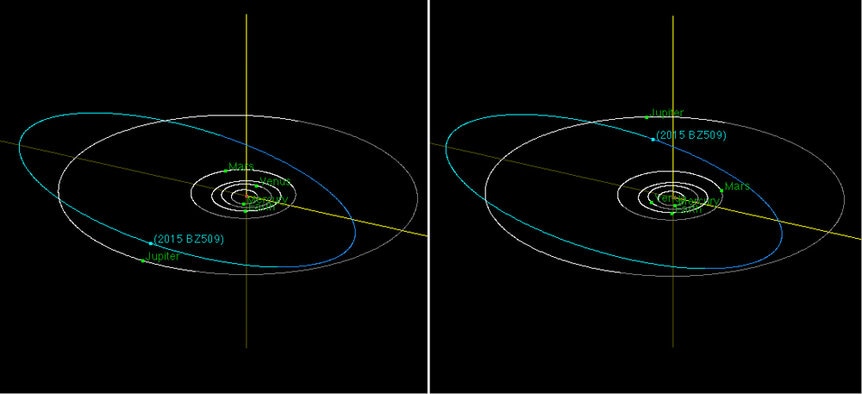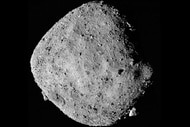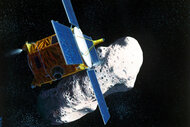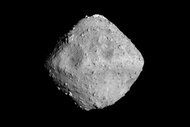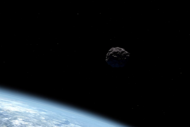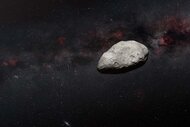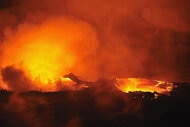Create a free profile to get unlimited access to exclusive videos, sweepstakes, and more!
Meet Jupiter’s backwards little friend: Asteroid 2015 BZ509
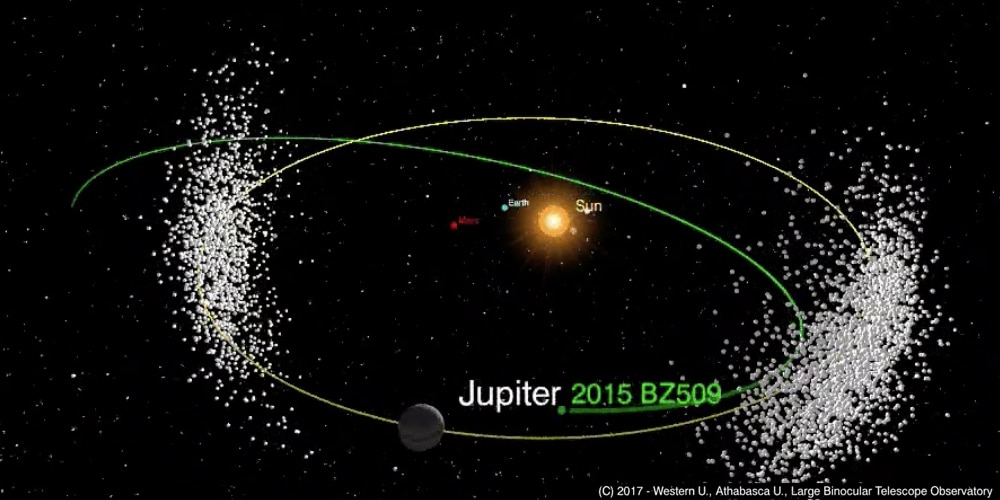
Imagine taking a rocket ride, a trip away from Earth. Calculating your course carefully (maybe using the Moon for a gravity assist), you change your trajectory so you head due north, straight up, if you will, out of the plane of the solar system. A few months later (space is big), you look back down at our family of worlds. What do you see?
If you’re patient, you’ll notice that all the planets orbit the Sun moving counterclockwise. And hey, the major moons of the planets (Earth’s Moon, Jupiter’s big Galilean moons, and so on) all move in that same sense, too.
We call this motion prograde (meaning roughly “forward motion”), and it’s left over from the formation of the solar system itself. Nearly all big objects orbit this way.
Nearly. A handful don’t. It’s rare; out of three-quarters of a million asteroids, for example, all but 80 orbit this way! The others orbit the Sun “backwards,” or retrograde. It’s not clear why they do, so every new one found is an important addition to the cadre.
Which brings us to just such a discovery. But this asteroid ... well, it’s really weird. Even for a retrograde asteroid.
It’s called 2015 BZ509, and it’s very roughly three kilometers in diameter. As the name implies, it was first discovered in 2015. Right away, it was clear it was retrograde. Intriguingly, though, the orbit calculated based on the observations showed it was in a similar orbit as Jupiter. Not exactly, but close. And that is very odd, indeed.
Why? Well, to be fair, lots of asteroids share Jupiter’s orbit. Due to a quirk in gravity, if you have a big object (like the Sun) with a smaller object (like Jupiter) orbiting it, there are places where the gravity and centrifugal forces balance, allowing objects in those regions to orbit stably. Asteroids in these orbits are, for historical reasons, called Trojan asteroids, and Jupiter has thousands of them.
But a critical factor for a Trojan asteroid is that it has to orbit the Sun prograde. If it shared Jupiter’s orbit but moved retrograde, it would encounter Jupiter twice every orbit, and in a battle like that, folks, Jupiter wins. The asteroid would be ejected by the planet’s mighty gravity in very short order.
So then, how can 2015 BZ509 manage to be where it is? Well, for one thing, it’s not a Trojan. It doesn’t share Jupiter’s orbit; it just has one that’s similar to it. And that’s the key to its survival. Watch:
Jupiter’s orbit is almost circular, so it stays the same distance from the Sun. BZ509, though, has an elliptical orbit, so it swings closer to the Sun than Jupiter for part of its orbit, and farther for the other part. It’s also tilted, inclined by roughly 17° to Jupiter’s*.
Because of the shape, it only gets about 300 million kilometers from Jupiter. However, that is close enough for Jupiter to affect the orbit gravitationally. So, how does BZ509 survive that?
Oh, this is my favorite bit. Yes, Jupiter tugs on the asteroid, but does so in such a way to make the orbit stable. On one pass, the asteroid passes outside Jupiter’s orbit, but half an orbit later it passes inside Jupiter’s orbit, so the big planet tugs on it the other way. The two effects cancel out!
Amazingly, this really is stable. A paper just published in Nature shows this to be the case. Astronomers used Large Binocular Telescope observations to nail down the orbit of BZ509 (which previously wasn’t accurately enough known to be sure), and found that it does, indeed, get shepherded by Jupiter, and the configuration it’s currently in could easily survive for a million years. So, it’s likely BZ509 has been performing this jovian dance for a long time.
... from one point of view. From another — the age of the solar system, 4.6 billion years — that’s a brief span. BZ509 was probably in another orbit for most of that time, then, and got tweaked somehow, maybe by Saturn†, which dropped it into this peculiar path.
Interestingly, another class of objects tends to have retrograde orbits: comets. It is possible, perhaps even likely, that BZ509 used to be a long-period comet, taking thousands of years or more to orbit the Sun. An encounter with an outer planet warped its orbit into a shorter one, and then a final poke set it on its current orbit.
The astronomers who did this work observed BZ509 very carefully, but found no hint of cometary activity from it —a cloud of gas surrounding it, due to ice sublimating as the Sun warms it. However, at the time, BZ509 was 500 million kilometers from Sun, which is right at the distance where ice can be stable. So, it’s not clear if BZ509 is more rocky, or if it has ice like a comet. More observations will be needed to make that determination.
One last thing. It’s easy to wonder what the odds are of BZ509 being put on just the right orbit to make it survive this long. What a coincidence, right?
Not really. Think of this: It’s possible that there are thousands, millions of objects on long, sweeping orbits like BZ509 used to be on millions of years ago. They get tweaked by Saturn (or some other planet), but then they wind up on orbits that bring them too close to Jupiter and they get flung away, or they never get very close at all and have more normal orbits. By coincidence, once in a while, one of these objects gets lucky and is placed in just such a way to have a weird orbit like BZ509’s. Rare, but you’re starting with so many objects it’s almost inevitable something like this would happen to one of them eventually.
This kind of thing occurs commonly in the solar system. Pluto has a weird orbit, too, paced in such a way that even though it gets closer to the Sun than Neptune, it never gets close to Neptune; every time Pluto is at that part of its orbit, Neptune is really far away, and they never meet. There may have been thousands of Pluto-like objects out there long ago, but they eventually got too close to Neptune, and went bye-bye. Those that had the right orbit survived. Many did (we call them Plutinos) and Pluto is just (maybe) the biggest of them.
Pretty cool! Our solar system is an amazing place. The more you look at it, the more amazing it becomes. It’s like a clock with a million working parts. It used to have even more, but the pieces that didn’t fit went away. What we’re left with is the fantastic machinery we see now. It’s a little bit like biological evolution; you have to look at deep history to understand what forces shaped what we see now.
And when you do, you have the literally awesome joy of grasping the heavens. It’s well worth the effort.
* Technically, its orbit is tipped by 163°. Inclinations are measured as if an object is orbiting prograde, with 0° being the same plane as Earth’s orbit. A 90° tilt would be perpendicular to that, and anything inclined between 90° and 180° is retrograde. So BZ509 has an inclination of 163°, but you can think of this as being tipped by 17° and moving retrograde. Complicating matters, Jupiter’s orbit is tipped about a degree from Earth’s, but I’m ignoring that here, because your head probably hurts enough already.
† Some moons of Saturn are co-orbital, very nearly sharing an orbit, and when they approach each other they swap positions; the inner one tugs on the outer one and vice-versa, so the inner one slows down and moves out, while the outer speeds up and moves in. They then swap again when their positions meet up, and the whole thing starts over again. This is similar to what’s happening with BZ509.
